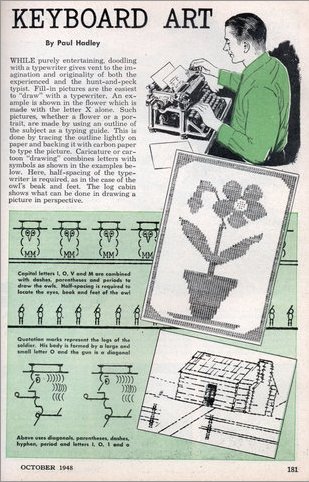 The Modern Merchanix Blog published in March, April and July 2006 three remarkable examples of nineteen thritees and fourties typewriter art, also known as keyboard art.
The Modern Merchanix Blog published in March, April and July 2006 three remarkable examples of nineteen thritees and fourties typewriter art, also known as keyboard art.The artwork was found in various preserved issues of the magazine "Popular Science" from 1939 and 1948. The Popular Science Magazine is still publishing today. They also have a website with a lot of (current ;)) content online. Visit the Popular Science Magazine Website.
The art was created by the artists on classic mechanical typewriter machines. "Personal" Computers did not exist at that time yet, the term computer was not coined yet either and the ASCII standard was still 20-30 years away in the future.
The following example is from 1939. One year earlier in 1938 did Germany’s Konrad Zuse finish the Z1, one of the first binary digital computers and a machine that could be controlled through a punch tape. The project started in 1936 and the Z1 is considered by many the "first computer" and Konrad Zuse the "Inventor of the modern Computer".
 Source: Popular Science Magazine,
Source: Popular Science Magazine, Issue: 6-1939
Typewriter Artist Produces Pictures Like Tapestry
by Rosaire J. Belanger
Pictures that resemble tapestry are produced with a typewriter by Rosaire J. Belanger, a mill worker in Saco, Me. Belanger first draws a pencil sketch on a sheet of paper, then inserts it in his typewriter and fills in the sketch with various characters to produce shading and outlines. With carbon paper, he transfers the picture onto graph paper, and copies it on blank paper.
Picture Description
George Washington, as pictured with a type-writer by Rosaire J. Belanger. At the left, the artist at the keyboard.

The following two examples are from 1948.
1948 is the same year when IBM built the SSEC (Selective Sequence Electronic Calculator). The IBM computer behemoth contained 12,000 tubes.

 Source: Popular Science Magazine,
Source: Popular Science Magazine, Issue: 7-1948
Typewritten Flag
by Menno Fast
Anyone can draw an accurate picture of the American flag on a typewriter, according to Menno Fast, a relief worker in Poland.
Fast read a recent Popular Mechanics article on drawing pictures with a typewriter.
He submits a drawing of the flag as proof that it can be made on an ordinary typewriter using standard spacing.
The flag, with a full 13 stripes and 48 stars, appears to be rippling in the wind.
 Source: Popular Science Magazine,
Source: Popular Science Magazine, Issue: 10-1948
KEYBOARD ART
By Paul Hadley
 WHILE purely entertaining, doodling with a typewriter gives vent to the imagination and originality of both the experienced and the hunt-and-peck typist.
WHILE purely entertaining, doodling with a typewriter gives vent to the imagination and originality of both the experienced and the hunt-and-peck typist. Fill-in pictures are the easiest to “draw” with a typewriter. An example is shown in the flower which is made with the letter X alone.
Such pictures, whether a flower or a portrait, are made by using an outline of the subject as a typing guide.
This is done by tracing the outline lightly on paper and backing it with carbon paper to type the picture.
Caricature or cartoon “drawing” combines letters with symbols as shown in the examples below.
Here, half-spacing of the typewriter is required, as in the case of the owl’s beak and feet.
The log cabin shows what can be done in drawing a picture in perspective.
Resources to Computer History
- The History of Computers - A Computer History Timeline at About.com.
- COMPUTER HISTORY - History from B.C. to today by Computer Hope.
Resources to Text Art History
- The History of ASCII (Text) Art by Joan G. Stark
- ASCII art at Wikipedia Encyclopedia
- 100 YEARS OF THE COMPUTER ART SCENE - Transcript (text), presented by Jason Scott and RaD Man (ACiD), Notacon Conference - Cleveland, Ohio, USA, April 23-25th, 2004
I hope you enjoyed the little trip back in time.
Cheers!
Carsten aka Roy/SAC
1 comment:
Cool post as for me. It would be great to read more about that matter. The only thing it would also be great to see on this blog is a few pics of any gizmos.
Alex Trider
Phone Blocker
Post a Comment
Hi, thanks for taking the time to comment at my blog.
Due to spam issues comments are not immediately posted on the site and require my manual approval first, before they become visible.
I try to approve comments as quickly as possible and usually within 24 hours.
To be notified about follow up comments that are made after yours, use the subscribe option with your email address and you will receive an email alert, if somebody else comments at this post in the future.
Also check out the rest of the website beyond this blog, visit RoySAC.com. Also see my YouTube channels, SACReleases for intros and demos.
Cheers!
Carsten aka Roy/SAC
Note: Only a member of this blog may post a comment.